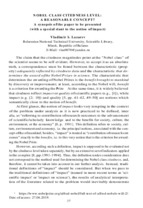| dc.identifier.citation | Lazarev, V. S. Nobel class citedness level: a reasonable concept? A synopsis of the paper to be presented (with a special slant to the notion of impact) / V. S. Lazarev // Наука, технологии, общество и международное нобелевское движение : Материалы Нобелевского конгресса - 12 Международной встречи-конференции лауреатов Нобелевских премий и нобелистов, 2-5 окт. 2019 г., г. Тамбов (Россия) / под ред. проф. В. М. Тютюнника. — Тамбов [и др.] : Нобелистика, 2019. – Вып. 7. Тр. МИНЦ. – С. 27-30. | ru |
| local.description.annotation | In accordance with the Nobel will, the characteristic that determines the awarding of Nobel Prizes is the benefit brought to mankind. Impact and quality of research documents seem to be the properties which are semantically close to the notion of benefit, and it is widely believed that impact and quality are the properties reflected by the figures of the citedness of research documents. These circumstances support the idea of the existence of a "Nobel citation level" of research works. However, comparison of the notion of impact (interpreted as “influence” or “strong impression”) with the possibilities of its quantitative evaluation by citedness data demonstrated the unreliability of citation counts as an aid of assessment of exactly the impact since in terms of cause-and-effect relationships, impact may or may not be the reason for the use of scientific documents reflected in their citedness data. (To the notion of impact more attention is paid than could be reflected in the present resume.) As for the quality of scientific documents, is not reflected by citedness (contrary to the popular belief): the mentioned indicator has no causal relationships with the given property. Being, by its very nature, primarily a “measure” of the use of scientific documents, citedness–via use–indirectly reflects value of cited works. The quality of scientific documents is a property that is adequately quantitatively characterized by peer reviewing. But due to the revealed correlation between the number of citations to the collections of documents and the results of their peer reviewing one can assume that the quality of scientific documents might be also evaluated by the citedness level. However, such an evaluation is purely probabilistic; it is not causal and therefore it is purely indicative. It such evaluation, a less accurate indicator is used a proxy. So, “Nobel class level of citedness” is a reasonable concept, but it is reasonable not due to the causal relations between citedness and benefit to mankind, but due to probabilistic relationships between citedness and quality, as well as to the proximity of the notions of quality and benefit to mankind. | en |

